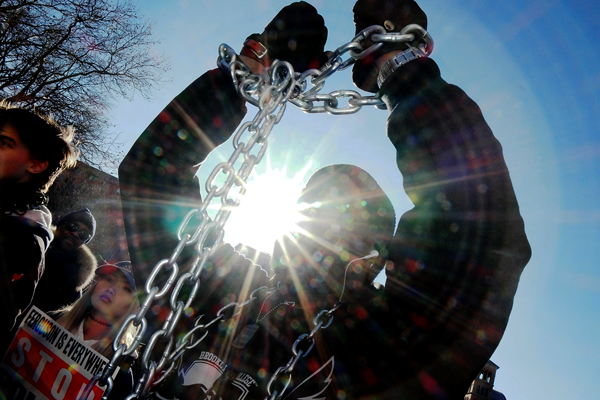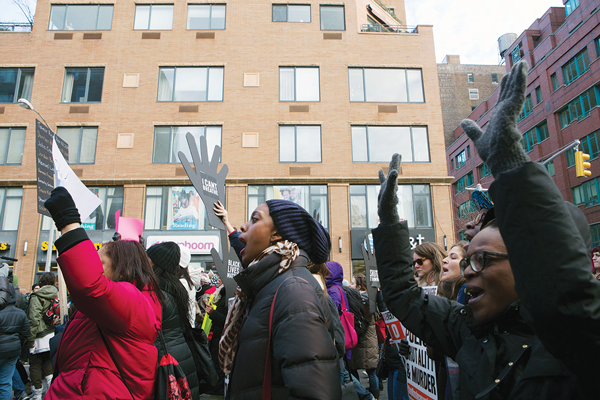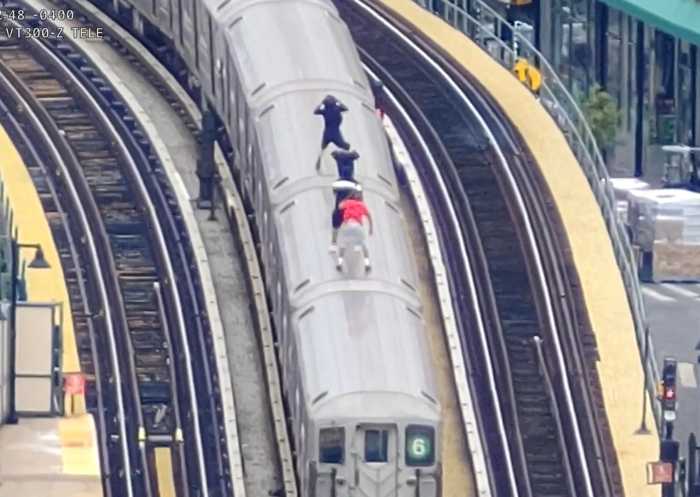
BY LINCOLN ANDERSON | The chant could be heard nearly all the way to Sixth Ave. on Saturday afternoon around 2 p.m. as droves of people — young and old, black, white, every skin color — began streaming out from Washington Square Park and onto Fifth Ave. for the Millions March NYC.
“Hands up! Don’t shoot! Hands up! Don’t shoot!” they shouted as one over and over, their voices echoing off the canyon walls of the avenue in the chilly air.
Carrying signs saying, “Black Lives Matter” and “Ferguson Is Everywhere” or large cardboard cutouts of black hands raised in the air and a segmented multi-panel image of a black man’s eyes toted by 10 people stretching across the avenue, they came — and came, wave upon wave.
A woman standing somewhere near the park arch fired up the crowd as she thundered into an electric bullhorn, “We will shut New York City down! Shut — it — down!”
“Hands Up!” she called out.
“Don’t shoot!” the crowd roared back in response.
“Take Fifth Avenue!” she exhorted them, though they already had.
The march had a permit, with the route stretching from Washington Square up to W. 14th St., then west across to Sixth Ave., then north up to W. 32nd St. and pivoting right around and back down Seventh Ave. and Broadway, ending at One Police Plaza next to the Brooklyn Bridge.
In all, it was a 4.5-mile marathon hike lasting four hours.
The number of people was estimated at 30,000. Many of them were young, and there appeared to be more white marchers than black.
It was 10 days after a Staten Island grand jury had failed to push charges against Police Officer Daniel Pantaleo, who used a chokehold — banned by the New York Police Department — to take down and arrest Eric Garner on Staten Island. “I can’t breathe,” Garner, who was obese and asthmatic, repeatedly pleaded during the arrest, during which he died. It was all captured on a cell-phone video that has been seen around the world.
The New York grand jury’s decision came close on the heels of a Missouri grand jury’s clearing of Officer Darren Wilson in the fatal shooting of Michael Brown in Ferguson.
Asked what she thought about the march as it set out from Greenwich Village, Jess Miller, 34, who lives in Washington Heights and works as a waitress in Harlem, said it was a good outlet for all that she was feeling about the emotional issue.
“I think it’s fantastic,” she said. “It feels good to have something physical to do instead of posting and posting [about it] on Facebook.”
Asked if she thought the march would have an impact, she said, “You can’t bring attention to things unless you make a lot of noise.”
A group of four SantaCon bar-crawl revelers, two men and two women, were trying to cross the avenue at 12th St., but gave up in the face of the rushing river of protesters.
“I’m not really sure how I feel about it,” said Colin Foley, 22, sporting shades and a red-and-white Santa hat and tunic, of the protest march. “It’s a pretty complicated issue. I understand why people are upset. It’s shades of gray. As a white male, a lot of these issues are about white males being the problem. I’m not sure how I feel about that,” he said before rushing off to join his friends on their way to a bar.
The marchers turned left onto 14th St.
“What do we want? Justice! When do we want it? Now!” they chanted, as people lined the street — some stood on top of a dumpster — watching and holding up their cell phones to film the historic event.
As the demonstrators headed up Sixth Ave., some of the chants turned virulently anti-cop.
“How do you spell ‘murder’!” some called out at one point. “N-Y-P-D!” came the response. Another hostile chant went “N.Y.P.D., K.K.K., how many kids did you kill today?”
“Eric Garner, Michael Brown — Shut the whole system down!” they shouted.
The sun was starting to set and the temperature drop. Near Herald Square, Jerry and Mary Raik, a teacher and a physician from the Upper West Side who looked to be in their 60s, said they didn’t plan to complete the whole route.
The march, he said, was “sending a clear message that there are a lot of people that understand that the system is broken. It’s not about the cops, it’s not about the grand jury. It’s about who runs the country — the power elite.”
His wife added, “There are a lot of people in jail that don’t belong in jail.”
Yasmeen Chisolm, 23, from the Bronx, said when she was a student at SUNY Albany she had joined a protest march after George Zimmerman was cleared for fatally shooting Trayvon Martin two years ago in Florida.
“It’s the same feeling — but maybe doubled over,” she said. “Even if they committed a crime, if they’re under a cop’s custody, the cop’s job is to get them safely to jail, to keep them alive.”

Asked if she felt the march would make a difference, Chisolm, a substitute teacher, said, “It’s going to take some time, but now is the time that change is really beginning. But I’m confident because it’s bigger than it ever was. Before it was for Trayvon. But now it’s more of a feeling of a big movement.”
Ralph Mater, 23, a banker who lives in the West Village near the new Lenox Hill HealthPlex, said he was happy to see a very diverse turnout.
He said that, growing up in the D.C. area, his white and black friends received different treatment from police who stopped them while driving, with the cops always going harder on his black friends.
“You look on TV, every week there’s somebody that looks like me being killed by police,” he said. “As a person of color, you have to be very careful. They’re hunting you — it feels that way. They want us in jail or dead — it feels that way. There are a lot of good cops out there. But there is a subdivision where there’s a feeling of racism.”
The protesters continued on through the Fashion District, past glum-looking Santas slumped by a building scaffold, silently watching them go by. On this day, overshadowed by the protest, no one cared about the Santas’ drunken antics.
Near Paragon Sporting Goods on Broadway the march got a bit backed up. Asked if all the protesting felt a bit like Occupy Wall Street, Greg Feliu, 19, a student at Hampshire College in Massachusetts, agreed that it did.
“I was a part of Occupy, and chanting in the streets and blocking traffic is terrific,” Feliu said. “But I wonder what else should we do? I don’t have all the answers.”
While Occupy’s message got diluted among many different goals, this protest movement is “more unified,” he noted.
Lande Yoosuf, 29, from Brooklyn, who works in TV in development and casting, called the massive march “the first step of other steps that need to happen.” The problems that need to be stamped out are “police brutality [and] white supremacy,” she said.
As for how to accomplish that, she said an “economic boycott,” referring to how a group of blacks in film and the arts had called on black people to boycott shopping on Black Friday.
“Look at the Montgomery bus boycott,” she said.
The march finally arrived at Foley Square. The word in the crowd was that “a hardcore group” would later try to take the Brooklyn Bridge, which did eventually happen. Two police officers on the bridge were injured when they were swarmed and attacked by protesters as the officers tried to arrest a man on the pedestrian walkway who they said was about to throw a garbage can down onto the bridge’s roadway. In a video of the two-minute scuffle, one protester is seen coming up behind one of the officers and yanking him down to the ground. One officer’s nose was reportedly broken.
A backpack containing three hammers that was left on the span, led police to arrest CUNY professor, Eric Linsker, 29, in Brooklyn, as the man who allegedly tried to throw the trash can.
At the end of the march, at Foley Square, one woman in her 20s who didn’t give her name said she supported the protesters’ tactic of blocking traffic on the streets and highways, since these are public.
“Power to the people!” she said.
Similarly, another woman, who said she is a local academic and who didn’t want to give her name, said she was deeply interested in the concept of infrastructure as public property. The city’s bridges and roads are owned by the people, she said, and thus it’s completely justifiable to occupy them during protest actions.
What specific reforms will come and whether Pantaleo will face any consequences for Garner’s death remain to be scene. However, as the sign of one marcher standing in Foley Square said, “America, we made you look.”

































